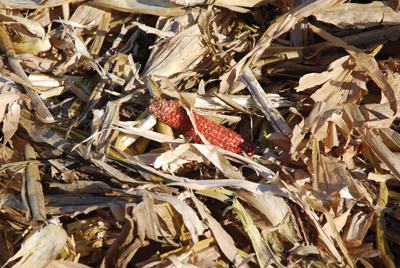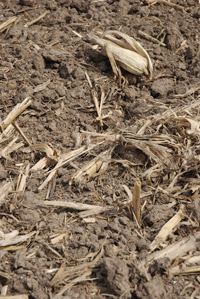
Features
Agronomy
Harvesting
Corn cob collection, cellulosic ethanol and soil quality
Commercial cellulosic ethanol production in Canada is inching closer to reality.
April 2, 2010 By Treena Hein
Commercial cellulosic ethanol production in Canada is inching closer to reality. Potential feedstocks of cellulose include corn cobs, corn crop residue, wood chips, trees, municipal solid waste, and pulp and paper industry byproducts. Making ethanol from these materials instead of using the actual corn kernels will both ease the controversial food versus fuel debate and use materials that would otherwise have been treated as waste.
 |
| Corn cobs are an ideal feedstock for making cellulosic ethanol, with a higher carbohydrate content than the rest of the plant, which creates more ethanol and could provide additional revenue for farmers. |
Plentiful and readily available, cobs are the ideal feedstock for making cellulosic ethanol. They have higher carbohydrate content than the rest of the plant, which allows more ethanol to be produced. In addition, because cob collection can be easily coupled with corn harvest, it involves both minimal extra effort and additional revenue for farmers.
Cobs make up a small percentage of stover and only a tiny fraction of total plant nutrient content. This means that taking them from the fields should have little overall impact on soil health. But with the potential for cob removal year after year about to be actualized, it is worth asking: will this practice have even small negative effects on levels of organic matter, pH, nutrients and on tilth or crop disease?
Representatives of Greenfield Ethanol do not believe so. In a small experimental batch lab at their Chatham, Ontario facility, the company has been making cellulosic ethanol from cobs since 2007. Bob Benson, Greenfield’s director of Cellulose Project Research and Development, says, “Cobs constitute only 10 percent of above-ground residues and approximately 15 percent of the dry matter left in the field. They are intrinsically low in nutrients, and so we believe that the removal of cobs will not cause a negative impact on the soil or on crop requirements for nutrients.”
Adam Hayes, soil management specialist with the Ontario Ministry of Agriculture, Food and Rural Affairs, agrees. “Most of the soil conservation benefits come from stalks and leaves,” he explains, “and so the impact of removing cobs on mitigating erosion is minimal.”
Benson adds, “In the US, producers who participate in USDA programs must maintain 30 per cent ground cover to minimize soil erosion, and the removal of corn cobs is in compliance with this requirement.”
Regarding other soil aspects, Hayes notes, “As the cobs represent a small percentage of the crop residue, removing them will remove only a small amount of organic material and nutrients, and will have little or no effect on soil pH.” He says removing them will also have little effect on soil tilth. “Tillage and cropping practices will have more impact on soil tilth and organic matter levels,” he concludes.
Benson adds, “Corn cobs, which take a few years to decompose, also initially take nitrogen from the soil during the decomposition process. As such, depending on a farmer’s crop rotation practices, the removal of corn cobs provides farmers with the potential to reduce the level of nitrogen per acre that must be applied.”
However, OMAFRA corn specialist Greg Stewart says “Given that cobs represent a small fraction of total corn stover, the change in N recommendations that would result from their removal would be inconsequential.”
Claims that corn cobs serve as overwintering habitat for both root worms and corn borers, and therefore that removing cobs would negatively impact these pests, are also discounted by Stewart. “First, corn borer move in from other fields and root worm reside in other parts of the residue,” he says. “Second, in Ontario grain corn production, we have virtually never sprayed to control corn borer, even before the advent of Bt hybrids. Applications of insecticides to control rootworm have been done in Ontario, but only when corn follows corn, and the need even in that situation is reduced now that we have Bt hybrids.”
The only other company using agricultural residues to make cellulosic ethanol in Eastern Canada is Iogen. Its demonstration facility in Ottawa, running since 2004 with a capacity of 5000 to 6000 litres per day, uses primarily wheat and barley straw.
Cob collection and cost-return
There are three well-known types of cob collection systems. With “grain-cob mix” collectors, both cobs and grain first end up in the combine grain tank. Grain is later separated into a wagon or truck and cobs are piled on the ground to be collected afterward. While this method uses existing combines with small modifications to the grain/cob separator, it requires special separation equipment to later separate cobs from grain, and an extra step to retrieve cobs from the ground.

|
| According to OMAFRA’s Adam Hayes, gathering only corn cobs will have little impact on soil tilth and organic matter levels.
Photos by Ralph Pearce.
|
The “whole cob collection” method involves normal combine operation with a cob cart or wagon towed behind. With the straw chopper and spreader disengaged, grain goes into the tank, and the rest goes onto a conveyor on a towed cart. Cobs and stover are then separated, with cobs going into the cart and stover back on the field. While this allows the farmer to easily transfer cobs to a wagon during harvest, it requires installation of in-cab controls and an approved hitch.
The third approach involves adding a cob-collection device on the back of the combine, so that grain and cobs are harvested in two separate streams. Farmers have to get used to pulling a wagon for cobs, but this method seems most efficient of the three. Vermeer Corporation of Pella, Iowa, and Case IH are developing one of these devices. Harvest Technologies of Kempton, Pennsylvania, has a patent on one as well, which costs $25,000 (C$) and weighs about 750 pounds. Harvest Technologies offers supply chain management solutions from equipment for harvest, handling and storage of cobs to transportation and pre-processing for delivery to the plant.
Harvest Technologies president Larry Shrawder says farmers find it quite easy to learn to pull a wagon. “Our device takes less power than a straw chopper, so it does not add to the fuel bill very much,” he notes. “It does take an extra hour to an hour-and-a-half per day to unload the wagon, but if farmers are collecting 25 to 30 tons of cobs per day and receive about $50 US per ton, that works out on average to an extra $1000 per hour for the extra work.”
Poet Ethanol is working with several partners on cob collection technology in preparation for Project Liberty, a $200 million commercial-scale cellulosic ethanol plant in Emmetsburg, Iowa, slated to begin production in 2011 and jointly funded by the US Department of Energy. These include John Deere’s “grain-cob mix” kit, being developed with researchers at Iowa State University and a ‘whole cob’ tow-behind harvester in the final stages of development at Redekop Manufacturing Inc. in Saskatoon, Saskatchewan.
However, at Project Liberty’s annual field day in early November 2009, both Case IH and AGCO introduced new baler prototype collectors that gather both cobs and stover into three-foot by four-foot square bales. These balers were developed through the most recent grants Poet received from the US Department of Energy, say industry insiders, because there is been a realization that cobs alone are not going to provide enough biomass to feed Project Liberty.
In a world where human population grows steadily alongside the price of oil and cheaply accessed fossil fuels are becoming scarcer, commercial cellulosic ethanol production is sure to be greeted positively around the globe. However, if large amounts of stover are removed from fields in the US Corn Belt to make this type of fuel, there are sure to be challenges ahead with soil health there.
In Ontario, Greenfield Ethanol’s corporate director of finance, Tim Leitch, says the company’s initial cellulosic ethanol feedstock will be corn cobs. “We hope farmers adopt cob collection wholeheartedly,” he says, “and that everyone will be doing it.”
For more information:
http://domesticfuel.com/2008/11/07/deere-designing-corn-cob-harvest-equipment/
http://www.vermeerag.com/equip/ccx770/
http://www.ipm.iastate.edu/ipm/icm/2007/8-6/nutrients.html
http://www.emmetsburgnews.com/page/content.detail/id/501914.html
http://www.challenger-ag.com/agco/Challenger/ChallengerNA/HayEquip/BiomassBaler.htm
http://www.agcoiron.com/default.cfm?PID=1.24.10